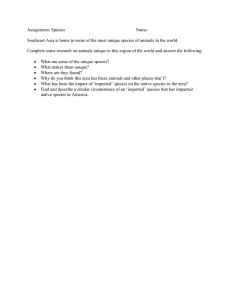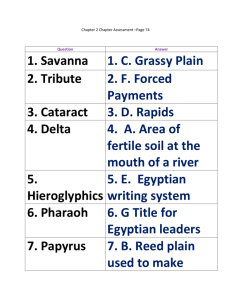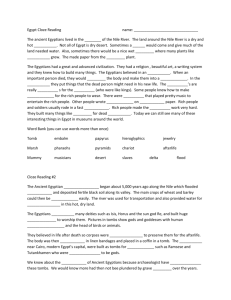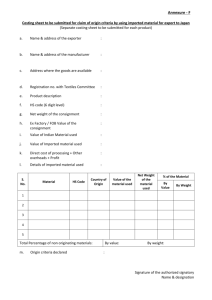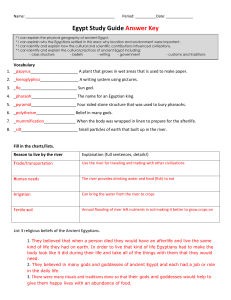Egypt Trade
advertisement
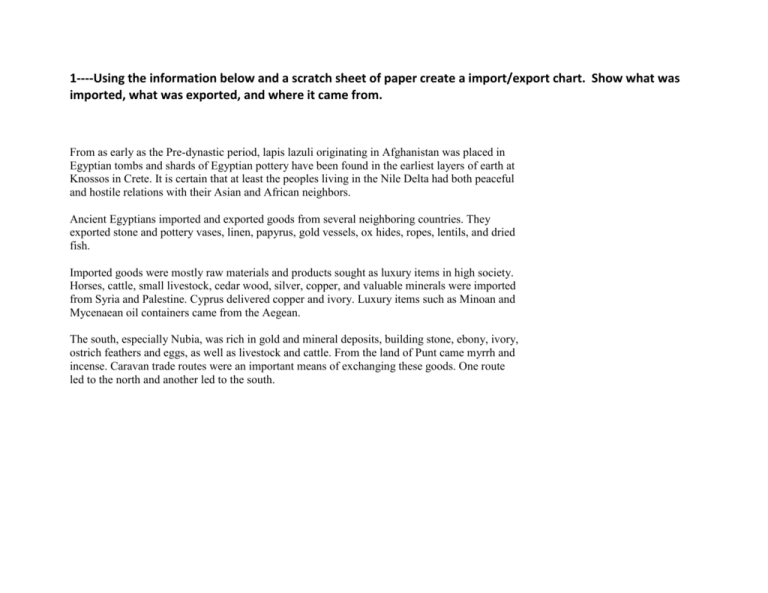
1----Using the information below and a scratch sheet of paper create a import/export chart. Show what was imported, what was exported, and where it came from. From as early as the Pre-dynastic period, lapis lazuli originating in Afghanistan was placed in Egyptian tombs and shards of Egyptian pottery have been found in the earliest layers of earth at Knossos in Crete. It is certain that at least the peoples living in the Nile Delta had both peaceful and hostile relations with their Asian and African neighbors. Ancient Egyptians imported and exported goods from several neighboring countries. They exported stone and pottery vases, linen, papyrus, gold vessels, ox hides, ropes, lentils, and dried fish. Imported goods were mostly raw materials and products sought as luxury items in high society. Horses, cattle, small livestock, cedar wood, silver, copper, and valuable minerals were imported from Syria and Palestine. Cyprus delivered copper and ivory. Luxury items such as Minoan and Mycenaean oil containers came from the Aegean. The south, especially Nubia, was rich in gold and mineral deposits, building stone, ebony, ivory, ostrich feathers and eggs, as well as livestock and cattle. From the land of Punt came myrrh and incense. Caravan trade routes were an important means of exchanging these goods. One route led to the north and another led to the south. 2--Using the Map below write down where Egyptians traded?. 3- Using the info below create a list of local goods and why they were needed/how they were used? The goods Much of what the Egyptians needed they had in their own country. Grain was generally plentiful and in Roman times Egypt was an important wheat growing area for the city of Rome. Beer, a less potent brew than its modern counterpart, was the daily drink of the people. Wine on the other hand was imported for a long time until vineyards were planted in the Delta and some of the oases. Bricks for building houses and palaces were made from the Nile mud, rocks for tombs and temples were found close to the Nile. Natron for embalming and salt were mined locally; flax and hemp grown for making clothes and ropes. Oil for lighting was pressed from the kikki seeds and later from olives. Papyrus grew abundantly in the Delta and was made into a kind of paper. Wood But Wood, a necessity for the building of houses, ships, furniture etc. was in short supply and of inferior quality. Already during the Old Kingdom Egypt began developing a special relationship with Byblos on the Lebanese coast, which became one of its closest allies for almost two millennia. The cedar wood imported was critical to the development of a navy capable of defending the country against the incursions of the Sea Peoples. Different varieties of hardwood, among them ebony, and fragrant wood were imported from Africa. Agricultural produce One of Egypt's main export products was grain, at first to the Lebanese coast, where often not enough corn could be grown locally, and later in large quantities to Rome, more than 100,000 metric tons per year under Augustus. Fruit, such as dates, were also sold abroad. At Camulodunum in Roman occupied Britain amphoras which had been filled with fruit of the doum palm were found, quite possibly of Egyptian origin. Papyrus Egypt was the only Mediterranean country where papyrus grew and a sort of paper was produced from it. It was marketed in the form of long rolls between ten and forty centimetres wide. It superseded the clay tablets used in the Akkadian speaking region and remained the main writing material in Europe until the Middle Ages, when its availability decreased and locally made parchment began to be used.
